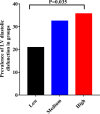Neutrophil-to-lymphocyte Ratio is Associated with LV Diastolic Dysfunction in the Overt Hyperthyroid Patients
- PMID: 35909508
- PMCID: PMC9329826
- DOI: 10.3389/fendo.2022.906947
Neutrophil-to-lymphocyte Ratio is Associated with LV Diastolic Dysfunction in the Overt Hyperthyroid Patients
Abstract
Background: Recent studies have shown that the neutrophil-to-lymphocyte ratio (NLR) has gradually been identified as a more reliable marker of inflammation, with predictive value for the development of many diseases. However, its association with left ventricular (LV) diastolic dysfunction in overt hyperthyroid patients is unclear. Here, we aimed to explore the relationship between NLR and LV diastolic dysfunction in overt hyperthyroid patients.
Methods: For this study, we retrospected the consecutive medical files of 350 overt hyperthyroid patients. Their medical data and laboratory findings were recorded. According to the presence or absence of LV diastolic dysfunction, the patients with overt hyperthyroidism were divided into two groups. One group with LV diastolic dysfunction included 104 patients and another group with non-LV diastolic dysfunction included 246 patients. The NLR values between the two groups were compared, and the relationship between NLR levels and the prevalence of LV diastolic dysfunction was also explored.
Results: The NLR value in LV diastolic dysfunction group in the overt hyperthyroid subjects was significantly higher than that in non-LV diastolic dysfunction group [1.100 (0.907-1.580) vs 1.000 (0.761-1.405), P=0.016]. The prevalence of LV diastolic dysfunction in Low- (NLR<0.879), Medium- (0.879< NLR<1.287), and High- (NLR >1.287) NLR level groups were 20.9%, 32.5% and 35.7% respectively. Moreover, increased NLR is associated with increased prevalence of LV diastolic dysfunction, and after adjustment for potential associated factors, NLR remained significantly associated with LV diastolic dysfunction. (OR = 11.753, 95%CI = 1.938-71.267, P = 0.007).
Conclusions: Our findings demonstrated that the NLR was associated with LV diastolic dysfunction in the overt hyperthyroid patients, and the prevalence of LV diastolic dysfunction may be positively correlated with NLR levels.
Keywords: echocardiography; hyperthyroidism; left ventricular diastolic dysfunction; neutrophil-to-lymphocyte ratio; prevalence.
Copyright © 2022 Zhang, Zhang, Li, Bi, Wang and Li.
Conflict of interest statement
The authors declare that the research was conducted in the absence of any commercial or financial relationships that could be construed as a potential conflict of interest.
Figures
Similar articles
-
Prevalence and Risk Factors of Left Ventricular Diastolic Dysfunction in Patients With Hyperthyroidism.Front Endocrinol (Lausanne). 2021 Jan 8;11:605712. doi: 10.3389/fendo.2020.605712. eCollection 2020. Front Endocrinol (Lausanne). 2021. PMID: 33488520 Free PMC article.
-
The association of plasma connective tissue growth factor levels with left ventricular diastolic dysfunction in patients with overt hyperthyroidism.Front Endocrinol (Lausanne). 2024 Feb 5;15:1333001. doi: 10.3389/fendo.2024.1333001. eCollection 2024. Front Endocrinol (Lausanne). 2024. PMID: 38375196 Free PMC article.
-
Association between neutrophil-to-lymphocyte ratio and left ventricular diastolic dysfunction in patients with type 2 diabetes mellitus.Front Endocrinol (Lausanne). 2025 Jan 10;15:1499713. doi: 10.3389/fendo.2024.1499713. eCollection 2024. Front Endocrinol (Lausanne). 2025. PMID: 39866734 Free PMC article.
-
Neutrophil to Lymphocyte Ratio Is Increased and Associated With Left Ventricular Diastolic Function in Newly Diagnosed Essential Hypertension Children.Front Pediatr. 2021 May 19;9:576005. doi: 10.3389/fped.2021.576005. eCollection 2021. Front Pediatr. 2021. PMID: 34095018 Free PMC article.
-
Clinical aspects of left ventricular diastolic function assessed by Doppler echocardiography following acute myocardial infarction.Dan Med Bull. 2001 Nov;48(4):199-210. Dan Med Bull. 2001. PMID: 11767125 Review.
References
Publication types
MeSH terms
Substances
LinkOut - more resources
Full Text Sources
Medical



